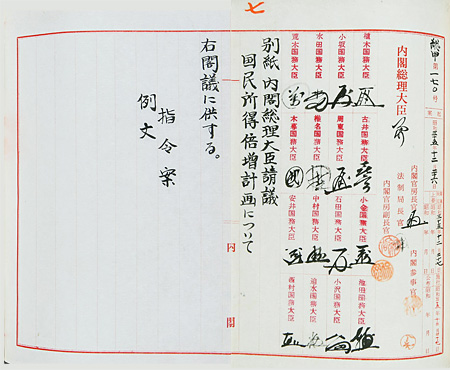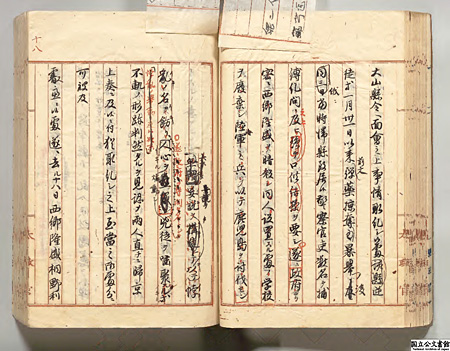Top>Research>Considering the Issue of Falsification of Public Records— from the Perspective of a Historical Researcher
 Index
Index
Considering the Issue of Falsification of Public Records
— from the Perspective of a Historical Researcher
Junichi Miyama
Associate Professor, Faculty of Letters, Chuo University
Areas of Specialization: Modern Japanese History and Archival Science
The issue of falsification of public records
Recently, news regarding the management of public records is frequently reported in newspapers, television programs, and Internet news. Some examples are the Moritomo Gakuen scandal, KAKE Educational Institution scandal and the cover-up of daily logs by Japan’s Self-Defense Force. These scandals are embarrassing incidents which reveal the low level of Japanese government and administration. However, as a former employee of the national government and a researcher of modern Japanese history, the falsification of public records related to Moritomo Gakuen struck me considerably.
Although it is nothing to be proud of, government officials have a sense of self-preservation in which they refrain from creating public records which are detrimental to them and from recording inconvenient facts—I’m sure that just about everyone realizes this as fact. Now that access to public records has become a right of Japanese citizens, officials realize how important it is for government institutions to manage records appropriately; nevertheless, their true intention is to eliminate any element which could subject them to criticism or misunderstanding.
Even so, it is hard to believe that officials would arbitrarily falsify documents that have already been created. Although the entire scope of the Moritomo scandal is not yet clear, the act of falsifying a public record poses enormous risk to a government official regardless of the circumstances. Disciplinary action will most certainly be taken, and there is even the possibility of criminal punishment in some cases. Accordingly, a government official would not falsify a document unless they are forced extreme resolution. Furthermore, even if the falsification were not discovered, simply participating in such an act would irreparably damage the dignity of any honorable government official.
The above is my reaction as a former employee of the national government. On the other hand, at the risk of seeming imprudent, I felt a sort of fresh surprise when considering the matter as a researcher of history.
Falsification and rewriting
In the case of the Moritomo scandal, the Japanese government uses the term “rewritten” instead of “falsified” in its explanation. According to the Shogakukan’s Japanese Dictionary, falsify (kaizan) is defined as “To alter the characters or words used in a document; rewriting. In modern Japanese, often used negatively to refer to alterations made for one’s personal convenience.” On the other hand, rewrite (kakikae) is defined as “To reword or rephrase.” In the Moritomo scandal, the Japanese government uses the moderate wording of “rewrite,” while the opposition party and mass media use the wording of “falsify” to imply malicious intent and denounce the LDP.
Some people might dismiss this as a mere difference in the expressions. However, from the perspective of a researcher in modern Japanese history, there is a huge gap between the two sides. Similar to many other researchers in the field of history, I have spent countless hours referring to and using public records ever since I entered university. Moreover, for a five-year period beginning from April 2011, I worked as a specialist in the management of public records at the Imperial Household Archives. During that time, I saw several examples of public records being rewritten. However, excluding extremely notorious cases of falsification, I have never directly witnessed public records being falsified.
Rewriting of public records

Figure 1: Cabinet decision document on National income doubling plan (from the collection of the National Archives of Japan)

Figure 2: Public record regarding the Seinan War of 1877 (from the collection of the National Archives of Japan)
In modern Japan, a system called ringi-sei (bottom-up decision making) has been used in the decision-making process at government and administrative institutions. In ringi-sei, bottom-up procedures are performed in which a project proposal is circulated in order from persons in low positions to those in high positions; for example, from the person who proposed the project to executive decision-makers. This decision-making process is visualized through the use of approval documents called kessai bunsho. Furthermore, materials detailing the process of deliberation are attached to the kessai bunsho. In some cases, the original proposal is edited prior to a decision being made. If complete revision is necessary, the project may be returned to the person who made the original proposal. In some cases, the project may be abandoned completely.
Among modern historical materials in Japan, there are many public records which clearly show the process of reviewing. Personally, I most frequently use public records from the Meiji Period (in modern Japan, public records are called kōbunsho; in the Meiji Period, they were called kumon/kōbun or kōbun-shorui). In many cases, traces of revision or supplement of the original draft as well as additions of reference opinions are left with strikeouts or as attachments. When these documents were edited, a clear record was kept of how the relevant sections were rewritten.
For example, when looking at the public record shown in Figure 2, you can see that corrections have been made to the original in red ink. Today, these corrections serve as important clues which show the process of trial-and-error undertaken by politicians and bureaucrats at that time. For officials at that time, these visible corrections were important measures which helped officials remember their own work in the future or pass on that work to their successors; in other words, corrections were essential to the continuity of projects.
Archives of public records which could not be realized
It is not my intent to sing the virtues of government officials in the Meiji Period. Indeed, fulfilling the government’s duty of accountability to citizens had nothing to do with the reason why officials created/acquired public records and then sorted those documents to save what they viewed as important. Even more, it was not their intention to organize materials for the historical research of future generations. They simply developed a system for the management of public records out of necessity for sustaining government organizations. Since these public records were not intended for external disclosure (disclosure to ordinary citizens), politicians and government officials were able to create documents and write the required information without worrying about compromising their position.
Even so, the Meiji government was aware of the form of European archives in which the national government and administration took responsibility for the storage of public records as public goods. The Iwakura Mission, which left Japan in 1871, visited Venice and was taken on a tour of the city’s archives. At the archives, they witnessed a collection of roughly 1.3 million documents spanning from the year 700 A.D. The Japanese government had also surveyed the systems used in other Western countries for the management of public records. In other words, the Japanese government knew of these systems, but chose not to apply them.
Public records serving as historical material
In 1971, the National Archives of Japan was opened and a vast amount of historical public records were disclosed to the general public. This occurred about 200 years after similar projects in Europe, which had begun the development of public record archives immediately after the French Revolution.
In April 2011, the Public Records and Archives Management Act took effect. Article 1 of the Act states as follows: “…public records and archives as records of historical facts and various activities of the State and Incorporated Administrative Agencies, etc. should be available … as an intellectual resource to be shared by the people in supporting the basis of sound democracy.” This was the first time that public records in Japan were clearly defined as the assets of sovereign citizens.
From among public records created or collected by government agencies, those documents judged as being historically significant are transferred to the National Archives of Japan (the Ministry of Foreign Affairs transfers documents to the Diplomatic Archives; the Imperial Household Agency transfers documents to the Imperial Household Archives) after the regular term of storage has expired. In principle, public records can be stored by government agencies for a maximum of 30 years. Upon being stored in the archives listed above, documents are immediately organized and disclosed to the general public.
Is it possible to see through falsification?
The public records which were falsified as part of the Moritomo scandal are genyō-bunsho (working documents); that is, they have yet to be transferred to the National Archives of Japan. Let us assume that no one had noticed the falsification of these documents and that these documents were transferred to the National Archives of Japan as normal. Unlike the traces of revisions which can be seen on public records from the Meiji Period, today’s documents bear absolutely no traces. Will historical researchers in the future be able to see through this falsification? Were some of the public records which I have read up to now actually falsified in the same way? This is my honest reaction as a historical researcher and the reason why the Moritomo scandal shocked me so much.
In the field of history, forged documents and books are sometimes the subject of research. This is an attempt to gain insight into political and social conditions at that time; specifically by analyzing the historical background which made it necessary to create forged books and documents.
If historical researchers were able to recognize falsified documents, it might be an extremely interesting research theme providing decisive insight into deception by the national government and administration. However, few researchers are constantly aware of the possibility that public records have been falsified. Moreover, even if a researcher were to possess such awareness, it would require extraordinary ability to discover falsification when absolutely no traces exist.
If deception such as the Moritomo scandal is occurring daily in Japan, then it might be essential for historical researchers to equip themselves with the ability to see through such falsification.
- Junichi Miyama/Associate Professor, Faculty of Letters, Chuo University
Areas of Specialization: Modern Japanese History and Archival Science - Junichi Miyama was born in Chiba Prefecture in 1982. He holds a PhD in history.
In 2005, he graduated from the Faculty of Letters, Chuo University.
In 2007, he completed the Master’s Program in the Graduate School of Letters, Chuo University.
In 2012, he completed the Doctoral Program in the Graduate School of Letters, Chuo University.
He served as a researcher at the Imperial Household Archives of the Imperial Household Agency, as Associate Professor at the National Institute of Japanese Literature, and as Associate Professor at Graduate University for Advanced Studies before assuming his current position in 2018.
His main research themes are history of the Meiji Restoration and history of records management. His main written works include Establishment of a National Funeral—Meiji Government and the Death of the Meritorious Retainer (Bensei Publishing, 2015), Society during the Boshin Civil War—Opposition between Supporters of the Shogunate and Loyalists to the Emperor (Shibunkaku Publishing, 2015) and more.
- Research Activities as a Member of Research Fellowship for Young Scientists (DC1), Japan Society for the Promotion of Science (JSPS) Shuma Tsurumi
- Important Factors for Innovation in Payment Services Nobuhiko Sugiura
- Beyond the Concepts of Fellow Citizens and Foreigners— To Achieve SDGs Goal 10 “Reduce Inequality Within and Among Countries” Rika Lee
- Diary of Struggles in Cambodia Fumie Fukuoka
- How Can We Measure Learning Ability?
—Analysis of a Competency Self-Assessment Questionnaire— Yu Saito / Yoko Neha - The Making of the Movie Kirakira Megane









